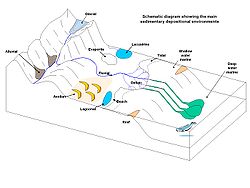Sedimentary depositional environment
- Sedimentary depositional environment
-
In geology, sedimentary depositional environment describes the combination of physical, chemical and biological processes associated with the deposition of a particular type of sediment and, therefore, the rock types that will be formed after lithification, if the sediment is preserved in the rock record. In most cases the environments associated with particular rock types or associations of rock types can be matched to existing analogues. However, the further back in geological time sediments were deposited, the more likely that direct modern analogues are not available (e.g. banded iron formations).
Types of depositional environment
Continental
Transitional
Marine
- Shallow water marine environment
- Deep water marine environment
- Reef
Others
Recognition of depositional environments in ancient sediments
Depositional environments in ancient sediments are recognised using a combination of sedimentary facies, facies associations, sedimentary structures and fossils, particularly trace fossil assemblages, as they indicate the environment in which they lived.
References
- Harold G. Reading. 1996. Sedimentary Environments: Processes, Facies and Stratigraphy. Blackwell Publishing Limited.
External links
Wikimedia Foundation.
2010.
Look at other dictionaries:
Sedimentary basin analysis — is a geologic method by which the history of a sedimentary basin is revealed, by analyzing the sediment fill itself. Aspects of the sediment, namely its composition, primary structures, and internal architecture, can be synthesized into a history … Wikipedia
Sedimentary rock — Middle Triassic marginal marine sequence of siltstones (below) and limestones (above), Virgin Formation, southwestern Utah, USA Sedimentary rock are types of rock that are formed by the deposition of material at the Earth s surface and within… … Wikipedia
sedimentary rock — Rock formed at or near the Earth s surface by the accumulation and lithification of fragments of preexisting rocks or by precipitation from solution at normal surface temperatures. Sedimentary rocks can be formed only where sediments are… … Universalium
sedimentary facies — Different, but contemporaneous and juxtaposed, sedimentary rocks. Terrigenous facies are accumulations of particles eroded from older rocks and transported to the depositional site. Biogenic facies are accumulations of whole or fragmented shells… … Universalium
Microbially induced sedimentary structure — This wrinkled elephant skin texture is a trace fossil of a non stromatolite microbial mat. The image shows the location, in the Burgsvik beds of Sweden, where the texture was first identified as evidence of a microbial mat.[1] Microbially ind … Wikipedia
Sediment — Cobbles on a beach River Rhône flowing into Lake Geneva … Wikipedia
Abu Rawash — (also known as Abu Roach ), 8 km to the North of Giza (coordinates coord|30|01|55|N|31|04|30|E|type:landmark), is the site of Egypt s most northerly pyramid, Also known as the lost pyramid the mostly ruined Pyramid of Djedefre, the son and… … Wikipedia
Channel pattern — Fluvial processes form several channel patterns, including: Straight, which are found in the most tectonically incised/active areas. This is more of a hypothetical end member, and are not often found in nature. Straight type channels can be found … Wikipedia
Eolianite — Holocene eolianite on Long Island, Bahamas. Eolianite or aeolianite is any rock formed by the lithification of sediment deposited by aeolian processes; that is, the wind. In common use, however, the term refers specifically to the most common… … Wikipedia
Interbedding — In geology, Interbedding occurs when beds (layers or rock) of a particular lithology lie between or alternate with beds of a different lithology. [ [http://www.ucmp.berkeley.edu/glossary/glossary I.html UCMP glossary] ucmp.berkeley.edu Retrieved… … Wikipedia

